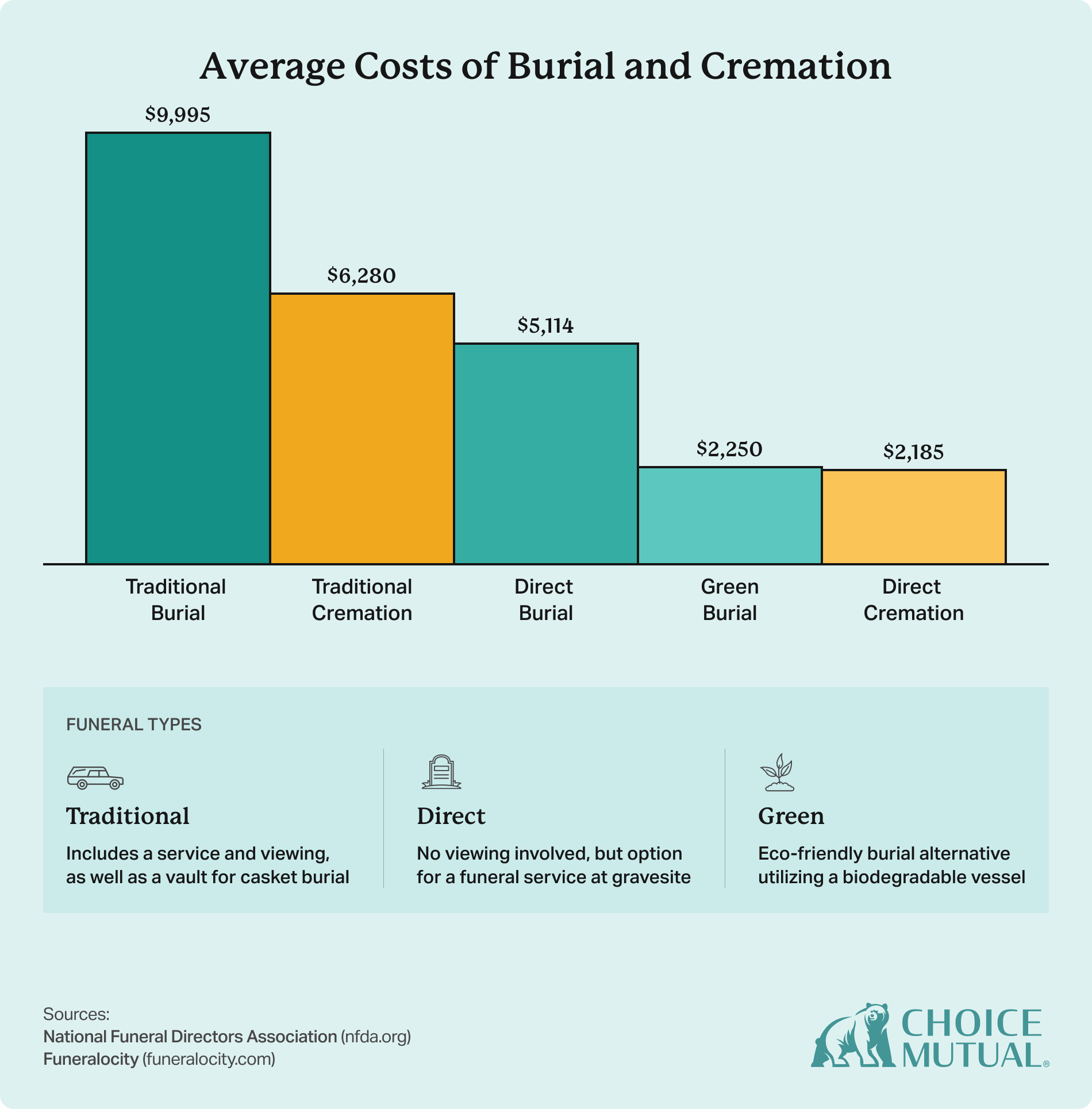Average Cremation Costs By State
According to the National Funeral Directors Association, the median cost of a cremation is $6,280, including a funeral service and body viewing.
| State | Cremation | Burial |
|---|---|---|
| Alabama | $5,858 | $7,615 |
| Alaska | $5,812 | $7,835 |
| Arizona | $5,505 | $7,390 |
| Arkansas | $5,890 | $7,912 |
| California | $5,812 | $7,835 |
| Colorado | $5,505 | $7,390 |
| Connecticut | $7,023 | $8,985 |
| Delaware | $6,103 | $8,023 |
| Florida | $6,103 | $8,023 |
| Georgia | $6,103 | $8,023 |
| Hawaii | $6,103 | $8,023 |
| Idaho | $5,812 | $7,835 |
| Illinois | $5,505 | $7,390 |
| Indiana | $6,120 | $8,280 |
| Iowa | $6,120 | $8,280 |
| Kansas | $6,713 | $8,755 |
| Kentucky | $6,713 | $8,755 |
| Louisiana | $5,858 | $7,615 |
| Maine | $5,890 | $7,912 |
| Maryland | $7,023 | $8,985 |
| Massachusetts | $6,103 | $8,023 |
| Michigan | $7,023 | $8,985 |
| Minnesota | $6,120 | $8,280 |
| Mississippi | $6,713 | $8,755 |
| Missouri | $5,858 | $7,615 |
| Montana | $6,713 | $8,755 |
| Nebraska | $5,505 | $7,390 |
| Nevada | $6,713 | $8,755 |
| New Hampshire | $5,505 | $7,390 |
| New Jersey | $7,023 | $8,985 |
| New Mexico | $6,498 | $8,573 |
| New York | $5,505 | $7,390 |
| North Carolina | $6,498 | $8,573 |
| North Dakota | $6,103 | $8,023 |
| Ohio | $6,713 | $8,755 |
| Oklahoma | $6,120 | $8,280 |
| Oregon | $5,890 | $7,912 |
| Pennsylvania | $5,812 | $7,835 |
| Rhode Island | $6,498 | $8,573 |
| South Carolina | $7,023 | $8,985 |
| South Dakota | $6,103 | $8,023 |
| Tennessee | $6,713 | $8,755 |
| Texas | $5,858 | $7,615 |
| Utah | $5,890 | $7,912 |
| Vermont | $5,505 | $7,390 |
| Virginia | $7,023 | $8,985 |
| Washington | $6,103 | $8,023 |
| Washington DC | $5,812 | $7,835 |
| West Virginia | $6,103 | $8,023 |
| Wisconsin | $6,120 | $8,280 |
| Wyoming | $5,505 | $7,390 |
Direct Cremation Costs
According to Funeralocity, the average direct cremation costs $2,183, and it’s the most affordable cremation type. It’s sometimes called “simple cremation,” “basic cremation,” or “immediate cremation.”
Direct cremation is when the cremation provider immediately cremates the body in a cremation container (aka “cremation casket”) and places it in an alternative container without a viewing or funeral service. Your loved ones cannot view the body or conduct a funeral ceremony before the crematorium incinerates the body.
It’s so inexpensive because you’re essentially just paying the cremation fees. You’re not paying for the burial plot, embalming, casket, headstone, refrigeration, funeral facility charges, or other basic services fees or additional costs.
The table below outlines direct cremation costs by state on a high, low, and average basis.
| State | Average | Low | High |
|---|---|---|---|
| Alabama | $2,023 | $695 | $4,375 |
| Alaska | $1,972 | $1,275 | $2,985 |
| Arizona | $1,433 | $400 | $2,890 |
| Arkansas | $1,676 | $595 | $3,595 |
| California | $1,585 | $438 | $4,450 |
| Colorado | $1,678 | $495 | $4,012 |
| Connecticut | $3,152 | $899 | $6,520 |
| Delaware | $2,616 | $1,195 | $5,000 |
| Florida | $1,683 | $484 | $5,190 |
| Georgia | $1,924 | $550 | $4,810 |
| Hawaii | $1,547 | $895 | $3,150 |
| Idaho | $1,699 | $765 | $2,825 |
| Illinois | $2,558 | $695 | $6,045 |
| Indiana | $2,282 | $595 | $5,695 |
| Iowa | $2,992 | $995 | $5,405 |
| Kansas | $2,530 | $695 | $7,245 |
| Kentucky | $2,019 | $690 | $4,450 |
| Louisiana | $2,313 | $610 | $4,149 |
| Maine | $2,348 | $825 | $4,830 |
| Maryland | $2,425 | $695 | $5,065 |
| Massachusetts | $2,696 | $995 | $5,305 |
| Michigan | $2,245 | $695 | $4,495 |
| Minnesota | $2,914 | $995 | $5,545 |
| Mississippi | $1,983 | $300 | $6,860 |
| Missouri | $1,849 | $635 | $4,780 |
| Montana | $2,478 | $995 | $4,090 |
| Nebraska | $2,960 | $995 | $5,100 |
| Nevada | $1,444 | $559 | $2,370 |
| New Hampshire | $2,176 | $1,275 | $4,738 |
| New Jersey | $2,510 | $786 | $5,810 |
| New Mexico | $1,940 | $725 | $3,700 |
| New York | $2,395 | $555 | $9,800 |
| North Carolina | $1,915 | $500 | $4,900 |
| North Dakota | $3,183 | $1,260 | $4,500 |
| Ohio | $2,047 | $575 | $4,375 |
| Oklahoma | $2,153 | $695 | $4,980 |
| Oregon | $1,281 | $595 | $2,440 |
| Pennsylvania | $2,456 | $500 | $6,360 |
| Rhode Island | $2,613 | $1,320 | $5,145 |
| South Carolina | $1,938 | $275 | $4,590 |
| South Dakota | $2,826 | $1,170 | $4,450 |
| Tennessee | $1,933 | $500 | $4,530 |
| Texas | $2,111 | $500 | $6,595 |
| Utah | $1,625 | $595 | $2,995 |
| Vermont | $2,295 | $1,290 | $3,405 |
| Virginia | $2,490 | $775 | $5,480 |
| Washington | $1,458 | $495 | $3,855 |
| Washington DC | $2,149 | $925 | $6,800 |
| West Virginia | $2,261 | $750 | $4,218 |
| Wisconsin | $2,871 | $800 | $7,538 |
| Wyoming | $2,533 | $1,295 | $3,580 |
Cremation Cost Calculator
Based on Inflation
Breakdown Of Cremation Funeral Costs
Cost Of Cremation Vs. Burial
Cremation pricing is much lower than traditional burial, which is why Americans are increasingly choosing cremations vs burials. The NFDA estimates that the cremation rate is expected to be 60.5%. In contrast, they expect burials to account for only 34.5% of funerals. Furthermore, the NFDA anticipates that cremations will account for 80% of funeral types by 2045.
The median cost of a cremation service with viewing is $6,280. However, if you opt for a basic cremation (the cheapest type), the average price drops to $1,924.
According to the NFDA, the average cost of a traditional funeral burial service with a viewing is $8,300 or $9,995 if you add a vault. The average price of a direct burial is $5,114, and green burials cost roughly $2,250.
How To Reduce The Cost Of A Cremation
Even though cremation funerals are cheaper than burials, they can still get very costly, depending on your preferences. Here are some functional ways to save money on a funeral:
- Shop around — Call at least five funeral homes or crematories for price estimates. Funeral homes, by law, must give you prices over the telephone if you ask. You’ll also need to arrange for the transfer of the body from the place of death to the funeral home or crematory. Check with multiple providers to ensure you get the best price possible.
- Get a general price list (GPL) — The FTC’s Funeral Rule grants you certain rights when shopping for cremation options. One such right is to see a General Price List (GPL) that spells out their crematory fees and the cost of all their products and other services.
- Make your budget unknown — Don’t tell any providers how much you can spend. Otherwise, they might offer a cremation package that matches your budget.
- Buy the urn somewhere else — It is your right to buy a cremation urn from a third party. By law, they must accept products from other providers. You can find affordable urns from online stores such as Amazon or Costco.
- Rent the casket for viewing instead of buying it — If you opt for a wake (viewing), you’ll need a casket to showcase the body. Funeral homes usually offer rental caskets for $750-$1,500. Comparatively, caskets can cost from $2,000-$10,000 on average if you buy one.
- Conduct the memorial at a private residence — Upon completing the necessary paperwork, holding a viewing ceremony of the deceased at your home is perfectly legal so friends and family can pay their last respects to the departed. Keep in mind that you’ll need to pay for the transfer of remains from your home to the crematory.
It’s wise to become familiar with all your rights under The Funeral Rule to ensure you get the best price possible for your desired service.
What You Can Do With The Ashes, Including The Cost
After the cremation process is complete, you must decide what will happen with the ashes. There are dozens of options, most of which are unknown to the general populace.
- Keep the cremains at home ($70-$2,250) — This is the most common option. You store the cremated remains in an urn and place them on a mantle or other place in your home for safekeeping. The only cost you incur is that of the urn.
- Keepsake urns ($25-$60) — These are tiny urns meant only to hold a portion of the cremains. The idea is that family members will all have their own keepsake urn to retain a part of their departed loved one.
- Scatter the ashes ($100-$1,000) — Some people want their ashes scattered as their final resting place. Many state and local governments have strict rules about scattering human cremains. It would be wise to check your local laws before scattering any ashes.
- Scattering gardens ($100-$1,000) — Some cemeteries have specific gardens set up where you can spread the deceased’s ashes.
- Scatter in water ($100-$1,000) — Dumping the ashes in a body of water is often called a “burial at sea” or “water burial.” You essentially drop a biodegradable urn (with the ashes inside), so it can dissolve in water. Or you can dump the raw ashes directly in the water. Check your state and local laws before disposing of cremains in a body of water. Many states have regulations that govern if and how you can spread human ashes in water.
- Burial (350-$3,000)– While uncommon, some people opt to bury the cremains. There may be additional fees if you work with a cemetery that requires an urn vault.
- Store in a columbarium or mausoleum ($1,000- $60,000) — A columbarium is a building that has little niches meant to hold urns. A mausoleum is a small house-like structure meant to store caskets or urns. Some mausoleums are very large and extravagant, making them extremely expensive.
- Cremation jewelry ($1,250-$13,200) — You can have a small portion of the ashes mixed in with the materials necessary to make a ring, pendant, or another piece of jewelry.
- Vinyl record ($2,250) — The ashes can be pressed into a vinyl record that plays whatever music you want.
- Tattoo ($200-$500) — The tattoo artist will add a small amount of the cremains to the ink. Then, they apply the tattoo like normal.
- Painting ($100-$1,000) — An artist will mix a small amount of the ashes into their paint.
- Space ($5,000-$12,500) — You can pay to have your ashes ejected into space.
- Coral reef ($4,500-$7,500) — Companies like Eternal Reefs use some of the ashes when they construct an artificial reef formation. Over time, this will attract and grow into an entire reef system in the ocean.
- Fireworks display ($400-$5,000) — Some ashes will be incorporated into the fireworks.
- Memorial tree ($6,700-$25,000) — Companies like Better Place Foresters will integrate some of the ashes into the soil near a dedicated tree that you select. They’ll also place a permanent marker on or near the tree, signifying who lies there.
There are many more options, including having your ashes dropped out of a plane.
Ways To Pay Cremation Expenses
Pre-planning your funeral is an act of love. Everyone should do it so that surviving loved ones don’t have to make hasty decisions under great emotional duress.
That said, how the funeral will be paid for is another critical funeral planning step. You cannot rely on Social Security because they only provide $255 after someone dies. Also, most states don’t offer financial assistance via Medicaid.
Here are the most practical ways to pay for the cost of cremating a person.
- Buy cremation insurance — A cremation insurance policy is a small whole life plan to pay for cremation costs. These plans last your entire life, and the monthly premiums remain level. After you die, your beneficiaries will get tax-free funds from the insurance company. There are no restrictions on how they spend the money. That means any unused money is theirs to keep. Bear in mind that a death certificate is required for your beneficiaries to be able to collect the money.
- Setup a pre-paid funeral — A pre-paid funeral plan is an agreement directly with a local funeral home. After you design your entire funeral, they will inform you of the net cost. There are a few different payment options. First, you can pay it all in cash and be done with it. You can also opt for monthly payments over many years. Once you pass away, the funeral home will execute your final wishes as you’ve designed. Pre-planning is very different than a final expense insurance policy. With a final expense policy, you typically name people, not the funeral home, as the beneficiary.
- Put money in a savings account — If you’re a disciplined saver, you can reliably put money into a savings account to one day have enough to cover the total cost. The money in this account should be explicitly earmarked for your final expenses. You must not touch this money when you encounter financial emergencies. Otherwise, life will happen as it always does, and then you’d have no money to pay for your cremation service. Also, it’s helpful to have someone else named on your account. If not, your bank account will be subject to the probate process. That would render the funds inaccessible for many months until probate is complete.
- Set up a POD account — A Payable on Demand Account is a unique bank account that includes a beneficiary(s). The money in the account will automatically be disbursed to your beneficiaries upon death. Ensure that your beneficiaries are aware of this account so they know to file a claim after your passing.
- Use existing life insurance — All types of life insurance payout cash to your beneficiaries. There is no reason the proceeds from existing life insurance cannot be used to pay for your cremation expenses. In fact, covering burial and final expenses is the #1 reason Americans purchase life insurance. Just be sure that your current life insurance won’t expire before you do. Some life insurance, such as term life, will expire after a specific number of years. Ideally, you want permanent life insurance if you’re counting on the policy to pay for your funeral bills. Many life insurance companies sell policies dedicated to paying just for final expenses. They’re often referred to as “burial life insurance” or “senior final expense life insurance.” Before making your final decision, compare offers from the best funeral insurance companies to find the policy that best meets your needs.
- Liquidate assets after death — Essentially, your family sells your real property and other items you own. That is the least ideal option because of how long it can take to sell off your assets. More than likely, your entire estate will likely need to go through the probate process (which can take months) before anyone can sell your valuables.
How To Get A No-Cost Cremation Via Donating Your Body To Science
If a funeral ceremony, memorial, or unique disposal of your ashes does not interest you, consider donating your body to science. If they accept you, they will cremate your body and return the ashes to your family free of charge.
You should be aware that some people will not qualify for a body donation.
For example, Mayo Clinic reports that you won’t be eligible if you have certain infectious diseases such as Hepatitis or HIV.
It’s important to remember that every organization that has a body donation program sets its own guidelines.
For example, Science Care would deny you because of an extremely high or low BMI.
If you plan to donate your body, it would be wise to ensure the receiving organization will accept you.
Frequently Asked Questions
According to the National Funeral Directors Association, the average cost of a cremation service with a viewing in 2023 was $6,280. Direct cremations, however, are much less expensive, typically costing roughly $2,000 with most funeral homes.
Direct cremation and direct burial are the cheapest types of funeral. A direct cremation typically costs $2,000 through a crematory, and a direct burial typically costs $5,114.
Yes, cremations can be carried out without a funeral. Often called “direct cremation” or “immediate cremation,” these are cremations without a memorial package of any kind. The body is immediately cremated, and the ashes are returned to the family.
Direct cremation is the most affordable type of cremation. With direct cremation, the body is immediately cremated without undergoing a viewing or funeral service of any kind. On average, a direct cremation costs about $2,000, depending on the funeral home.
- Nationally licensed life insurance agent with over 15 years of experience
- Personal annual production that puts him in the top .001% out of all life insurance agents in the nation.
Anthony Martin is a nationally licensed insurance expert with over 15 years of experience and has personally served over 10,000 clients with their life insurance needs. He frequently authors entrepreneurial and life insurance content for Forbes, Inc.com, Newsweek, Kiplinger, and Entreprenuer.com. Anthony has been consulted as an expert life insurance source for dozens of high-profile websites such as Forbes, Bankrate, Reuters, Fox Business, CNBC, Investopedia, Insurance.com, Yahoo Finance, and many more.
- Nationally licensed life insurance agent with over 19 years of experience
- Best selling Amazon author.
Jeff Root is a nationally licensed life insurance expert with over 19 years of experience. He has personally helped over 3000 clients with their life insurance needs. Jeff is a best-selling Amazon author and the managing partner of a highly successful insurance brokerage that manages over 2,500 licensed insurance agents across the USA. He has been a featured life insurance source for prestigious websites such as Forbes, Bloomberg, MarketWatch, Nerdwallet, and many more.
- Nationally licensed life insurance agent with over 14 years of experience
- Best selling Amazon author of five insurance sales books.
David Duford is a nationally licensed insurance expert with over 14 years of experience. He has personally helped more than 15,000 clients buy life insurance. David has been featured as an expert source for highly authoritative publications such as A.M. Best and Insurancenewsnet. He also runs one of the largest Youtube channels to help aspiring insurance agents serve their clients better.
- Nationally licensed life insurance agent with over 19 years of experience
- Best selling Amazon author.
Jeff Root is a nationally licensed life insurance expert with over 19 years of experience. He has personally helped over 3000 clients with their life insurance needs. Jeff is a best-selling Amazon author and the managing partner of a highly successful insurance brokerage that manages over 2,500 licensed insurance agents across the USA. He has been a featured life insurance source for prestigious websites such as Forbes, Bloomberg, MarketWatch, Nerdwallet, and many more.
- Nationally licensed life insurance agent with over 14 years of experience
- Best selling Amazon author of five insurance sales books.
David Duford is a nationally licensed insurance expert with over 14 years of experience. He has personally helped more than 15,000 clients buy life insurance. David has been featured as an expert source for highly authoritative publications such as A.M. Best and Insurancenewsnet. He also runs one of the largest Youtube channels to help aspiring insurance agents serve their clients better.
Choice Mutual often cites third-party websites to provide context and verification for specific claims made in our work. We only link to authoritative websites that provide accurate information. You can learn more about our editorial standards, which guide our mission of delivering factual and impartial content.
-
NFDA. https://nfda.org/news/media-center/nfda-news-releases/id/8134/2023-nfda-general-price-list-study-shows-inflation-increasing-faster-than-the-cost-of-a-funeral
-
Funeralocity. https://www.funeralocity.com/average-funeral-price
-
National Funeral Directors Association. https://nfda.org/news/media-center/nfda-news-releases/id/8134/2023-nfda-general-price-list-study-shows-inflation-increasing-faster-than-the-cost-of-a-funeral
-
Funeralocity. https://www.funeralocity.com/average-funeral-price
-
Direct cremation. https://www.cremationsocietyofamerica.com/what-is-a-direct-cremation/
-
NFDA. https://nfda.org/news/statistics
-
NFDA anticipates. https://nfda.org/news/media-center/nfda-news-releases/id/7717/us-cremation-rate-expected-to-top-80-by-2045
-
NFDA. https://nfda.org/news/media-center/nfda-news-releases/id/8134/2023-nfda-general-price-list-study-shows-inflation-increasing-faster-than-the-cost-of-a-funeral
-
FTC’s Funeral Rule. https://consumer.ftc.gov/articles/ftc-funeral-rule
-
General Price List. https://www.ftc.gov/business-guidance/resources/complying-funeral-rule#the-general-price-list
-
Amazon. https://www.amazon.com/urns/s?k=urns
-
Costco. https://www.costco.com/urns-urns.html
-
rental caskets. https://dfsmemorials.com/cremation-blog/save-money-using-a-rental-casket-for-a-cremation-service/
-
The Funeral Rule. https://www.ftc.gov/news-events/topics/truth-advertising/funeral-rule
-
mausoleum. https://trustedcaskets.com/blogs/news/what-is-a-mausoleum-the-pros-and-cons
-
space. https://www.celestis.com/
-
Eternal Reefs. https://www.eternalreefs.com/
-
Better Place Foresters. https://www.betterplaceforests.com/
-
plane. https://www.ajourneywithwings.com/
-
Social Security. https://www.ssa.gov/benefits/survivors/ifyou.html
-
probate process. https://www.americanbar.org/groups/real_property_trust_estate/resources/estate_planning/the_probate_process/
-
Payable on Demand Account. https://www.nolo.com/legal-encyclopedia/free-books/avoid-probate-book/chapter1-1.html
-
term life. https://www.investopedia.com/terms/t/termlife.asp
-
Mayo Clinic. https://www.mayoclinic.org/body-donation/why-donation-denied
-
Science Care. https://www.sciencecare.com/resources/faq-whole-body-donation-science-care#pre
-
bls.gov. https://www.bls.gov/opub/ted/2017/the-rising-cost-of-dying-1986-2017.htm
-
columbarium. https://www.cem.va.gov/cem/grants/columbarium_cremain_burials.asp









